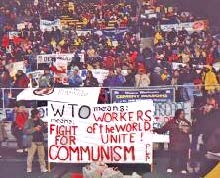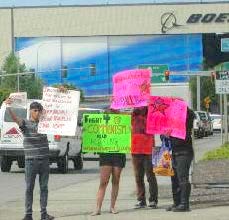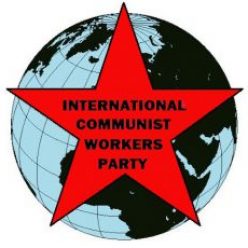When Masses Debated Communism
Only social practice can be the criterion of truth. —Mao Zedong

Seattle, 1999
SEATTLE (USA), Nov. 30— Here, twenty years ago, fifty thousand demonstrated against the World Trade Organization (WTO). They broke martial law and fought cops in the streets for days. US President Clinton and his Secretary of State were trapped in their hotel rooms.
In the midst of this “Battle of Seattle” US comrades fought for a communist vision. This helped put us on a path towards forming a party that mobilizes the masses for communism: the International Communist Workers’ Party (ICWP).
Leading capitalist nations established the WTO supposedly to govern international commerce. US imperialists viewed it as another vehicle to ensure their dominance.
It failed. The emergence of other imperialists and the beginning of the long decline of US power became clear. The battle foreshadowed the choices ahead: fascism or communism.
During the preceding week, protestors with different causes poured into Seattle. Debates erupted about what to do.
The US ruling class thought their usual agents would control the protestors. Then-AFL-CIO president Sweeney vowed to “support US interests.” Well-funded non-governmental organizations (NGOs) formed the other arm of the reformist bloc.
But mobilizing students and workers, especially industrial workers, turned out to be a big problem for them. Our comrades saw the potential to fight for our communist vision.
A Global Exchange workshop panelist said he wasn’t against the accumulation of wealth (billionaires). He just wanted better wealth distribution. A young comrade explained how capitalist accumulation of individual wealth leads to greater exploitation, economic crisis and eventually to war. The Global Exchange organizer responded by advocating for “cool capitalism.”
That night, the comrade said it wasn’t good enough to be anti-capitalist. We needed to show how communism is the solution to capitalist exploitation.
We took this self-criticism to heart. The next day, we confronted a panelist who said communism was too simplistic. We explained how to build a new system without wages and commodity production. We won the majority of the 400 participants to applaud communism.
About 1,000 workers and students heard our communist message during that week.
The Day of the Battle
Meanwhile, Boeing comrades and friends built their forces in the plants. Hundreds of Machinist Union members comprised the march’s security force. We organized a critical communist core within this force.
This core helped others distribute over 8,000 pieces of communist literature. They helped comrades bring a “Fight for Communism” banner into the unions’ rally at Memorial Stadium.
Thousands in the stands saw it. Nearly everyone was discussing communism. A couple called later to say that those debates “made their day.” Responses like this gave our comrades confidence to give communist speeches as 20,000 streamed out of the stadium.
Soon after, we led the chant, “It’s time to march, it’s time to go!” The protestors took off, leaving the union hacks behind.
At a crucial moment, the communist core won an even bigger security group to ignore AFL-CIO orders. The union big shots told us to direct 30,000 industrial workers to a peaceful sit-down far from the fighting downtown.
Instead we offered the rank-and-file the option to enter the battle. Thirty thousand did. The ruling class lost control.

ICWP, Seattle, 2012
The Aftermath
A Boeing comrade was kidded upon returning to work. “Was it you setting fires downtown?”
“I did something much more radical,” our comrade answered. “I spread the communist alternative by distributing communist literature in the midst of the battle.”
“I listened to a two-hour presentation of alternatives to the present state of affairs at a WTO teach-in,” said a high school teacher at our follow-up potluck. “Why can’t we have a two-hour presentation of your communist vision? That’s what will motivate people.”
After an hour-long discussion, she told us, “I may not have gotten two hours, but I did get one!”
Comrades in many places seized the opportunity to present our communist vision. Frankly, we were shocked at the mass response to our line.
We weren’t the only ones. We expected to earn the hatred of the bosses’ reformist agents. But we hadn’t anticipated the consternation of those on the “left” who wanted to ingratiate themselves in the reform movements.
Even leaders of the party our comrades belonged to then (PLP) thought that recruiting communist activists would isolate us. They said recruitment had to rely on advancement (often personal) in reformist organizations “for the foreseeable future.” They feared our bold communist approach.
To the contrary, we thought we were too timid. We made many contacts, but we should have recruited many more communist activists. Our key weakness was that we didn’t have a party that made recruiting communist fighters a priority.
We do now. After more and sharper disagreements like this one, we split from PLP ten years later to form the ICWP. Our upcoming conferences will mark ten years of fighting openly and directly for communism. Let us take with us the key lesson of the Battle of Seattle and build the ICWP.
The Battle of Seattle Through the Eyes of Boeing Workers Who Were There
A group of friends informally discussed their experiences during the Battle in Seattle twenty years ago. Some are still working at Boeing; others have retired. Two were in the communist core among the security forces. Another marched with union leaders and a local congressman. Everyone gained a new perspective as we swapped stories.
One core member recalled the struggle among security forces at the front of the march. The machinist union leaders argued that we should march against Chinese prison labor. Comrades and friends countered that Boeing was exploiting prison labor twenty miles north at Monroe prison. This argument held up the march, but not for long.
This story had a profound effect on our friend who marched with the bigwigs. He started to view the role of reformist unions differently. “You can put lipstick on a pig,” he concluded, referring to the union leaders, “but, it’s still a pig.”
He admitted that reformism in general was not working. We had fought for an extra 25 cents for decades. Most times we didn’t even get that. Meanwhile, the bosses were raking in billions.
Eventually we got to the main contradiction that was holding him back from joining the party.
We talked about the effect of working as a party had on the masses of demonstrators. And the effect the enthusiasm of the masses had on us!
We were not a collection of reformists or anarchists, but a disciplined party. He stood up and took notice.
He had viewed his role as having a “place at the table.” But now he thought he should be a spy, so we can know what is going on. Our recollections about the mass response to communism gave him hope but couldn’t completely break the hold of reformist politics. The struggle continues.
Front page of this issue

